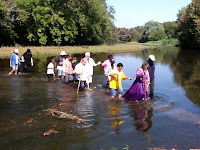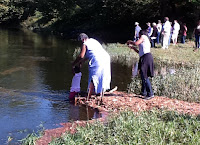Formerly enslaved African Americans, with an oxcart, cross the Rappahannock River at Cow Ford near Rappahannock Station on Aug. 19, 1862. Martin’s Mill and the Orange & Alexandria Railroad bridge are behind them. (TIMOTHY H. O’SULLIVAN/LIBRARY OF CONGRESS)
BY CLINT SCHEMMER
THE FREE LANCE-STAR
Cow Ford has an everyday name.
But it is an extraordinary place.
This weekend, hundreds of people—coming from near and far—testified with their presence to its significance in American history.
They came to honor the enslaved African–Americans who risked all to cross the Rappahannock River there during the Civil War, fleeing to freedom behind Union lines.
And with words, song and deed, they celebrated President Lincoln’s issuing the Preliminary Emancipation Proclamation, 150 years ago to the day.
The spot, the watery border between Culpeper and Fauquier counties, was “the end of the Underground Railroad” for those who dared to wade the ford near Rappahannock Station in 1862, said Dianne Swann–Wright, director of African–American and Special Programs at Monticello.
As keynote speaker of the “Crossing the Rappahannock: A Pilgrimage to Freedom” event, Swann–Wright noted the guts it took those individuals to leave the lives and places they’d known for a hugely uncertain future.
She marveled at a wartime description of how one party of African–Americans—their oxcart stalled, the “angry rattle” of musket fire nearby—sent their children running across the ford ahead of them to the Fauquier side, held by the Union army.
Those children were “their most precious possession,” Swann–Wright said. And their parents were sending them off to a fate of which all could only guess. Bounty hunters, after all, roamed the disputed and ever-changing border between Union and Confederate territory, ready to seize slaves and return them to their owners.
John Hennessy, chief historian of Fredericksburg and Spotsylvania National Miltary Park, said that moment was one where people chose what sort of future they might have: enslaved, or free. So, too, did Lincoln change the course of the nation a century and a half earlier.
Hennessy shared the account of Col. Theodore Gates of the 20th New York State Militia, whose unit crossed here on the morning of Aug. 20, 1862.
In the regiment’s history, Gates wrote:
“One party of them approached the ford a few rods below the bridge, where the water was two or three feet deep, with an ox-team drawing a wagon, filled with their worldly goods, and on top of these were three wenches, and a perfect swarm of ebony children.”
“ Quick as thought those black mothers seized their youngest children, and, followed by the others sprung to the ground, looking, in their descent, like fragments of night, dropping from the sky, and dashed through the water.
“As they ascended the opposite bank, the matron of the party clasped her hands, and, looking up to heaven, exclaimed: ‘Bress de Lord–we’se on dis side ob Jo’don!’”
The officer’s remembrance adds drama to an already iconic photograph, taken the day before, of an African–American family crossing the ford as Union soldiers watched, Hennessy said.
Irish immigrant Timothy O’Sullivan, one of the best photographers with Mathew Brady’s studio, was at the ford, just below Tin Pot Run, exposing wet plates to record the Orange & Alexandria Railroad bridge there when the family, with its heavily laden oxcart, appeared on the road entering the ford from the Culpeper side.
Working quickly, O’Sullivan took two stereoviews, now preserved in the photographic archive at the Library of Congress.
They comprise one set of perhaps two instances, in the entire war, where a photographer candidly recorded African–Americans running to liberty across the lines between warring armies, Hennessy said.
Because of that quality—and its storytelling nature, O’Sullivan’s photo has been widely published and used in many historical documentaries, including Ric Burns’ recent PBS show “Death and the Civil War.”
Virginia Deputy Secretary of Natural Resources Anthony Moore spoke beside the river, sharing a certificate of recognition from Gov. Bob McDonnell that honored the occasion and the history it commemorated.
Howard Lambert of the African American Heritage Alliance Inc., which hosted Saturday’s event, said O’Sullivan’s image crystallizes the struggle that African–Americans endured to make it to freedom.
In the climax to three hours of prayer, talks, a walk and hymns, Lambert carefully led some 20 adventurous souls across the 1,200-foot-long ford up the Rappahannock to the site of the Orange & Alexandria bridge and Martin’s Mill, retracing the path the slaves took 150 years earlier.
The “river walkers” included a mix of people, from a boy of about 10 to a woman of 60 or 70.
As they waded and splashed against the river’s current, up and back again, part of the Emancipation Proclamation was read and the a cappella River Bank Choir serenaded the group, its harmonies reverberating beautifully between the Rappahannock’s high banks.
Also read aloud were the recently uncovered names of Culpeper men, many of them once enslaved, who enlisted with the United States Colored Troops—created as a result of Lincoln’s emancipation decree—to fight for the Union. Some of those men might have crossed to freedom at the same spot, or re-crossed the river later, headed south with the Union army in 1864 as it began the Wilderness Campaign. Among the dozens of their names: Robert Gibson, Lewis Barber, Frank Allen and William Bell.
Spotsylvania resident Denise Benedetto, director of the Women of the American Civil War Era, echoed other participants in saying that the day was an important one—to honor people “whose names don’t appear in the history books.”



















 ‘Black South-Easter’ by director Carey McKenzie, starring Tony Kgoroge, is set in Cape Town and tells a story of police corruption. I’m told it has a very good soundtrack too. No trailer yet.
‘Black South-Easter’ by director Carey McKenzie, starring Tony Kgoroge, is set in Cape Town and tells a story of police corruption. I’m told it has a very good soundtrack too. No trailer yet.